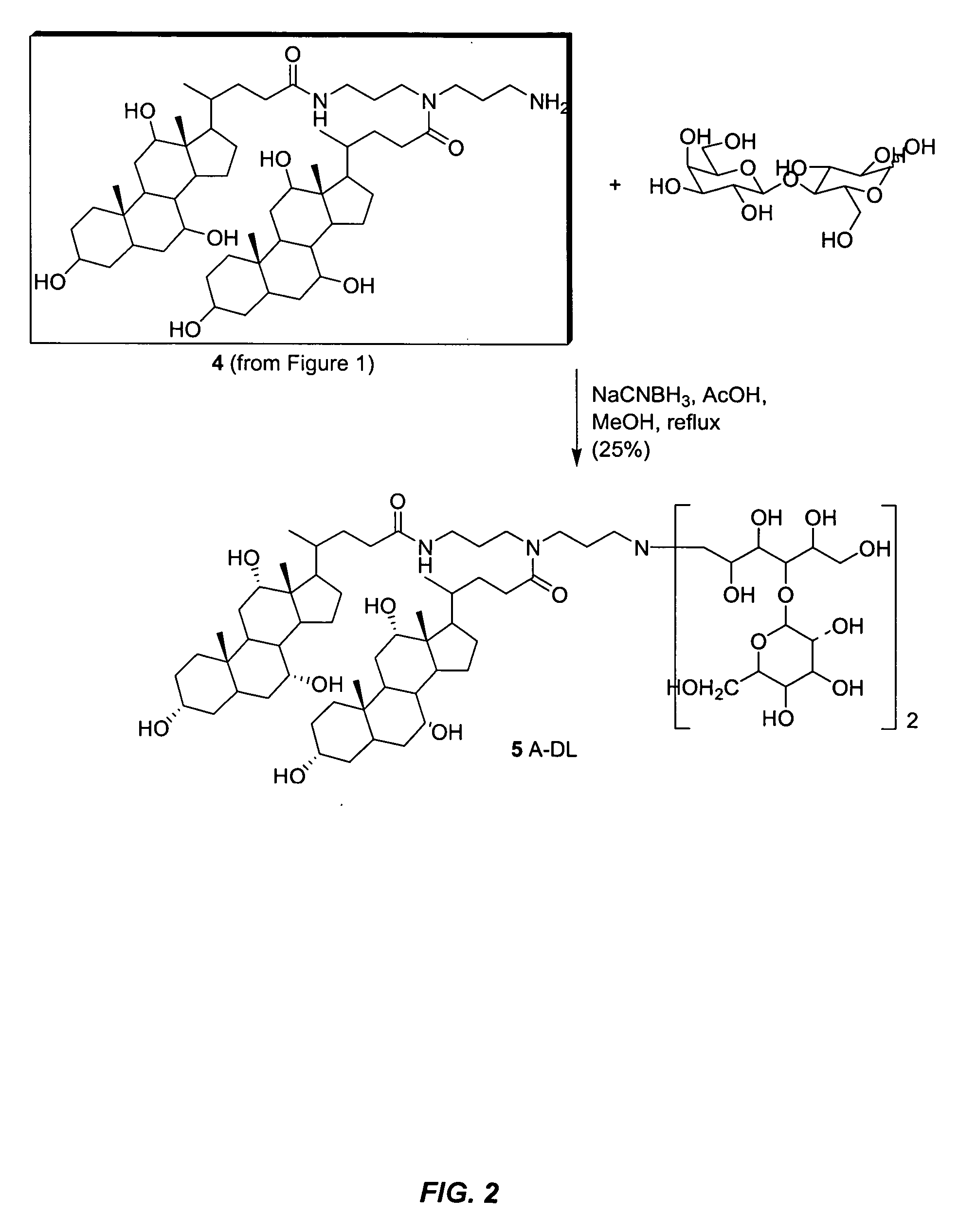Transfection agents
a technology of transfection agent and cell, applied in the field of transfection agent, can solve the problems of significant morbidity and mortality from bladder cancer, and achieve the effect of enhancing the delivery of an agent to the cell
- Summary
- Abstract
- Description
- Claims
- Application Information
AI Technical Summary
Benefits of technology
Problems solved by technology
Method used
Image
Examples
example 1
Synthesis of Compound A-DL (see FIGS. 1 and 2)
[0080] The following relates the methodology utilized in the synthesis of compound 5, also know as A-DL. Provided below are the synthetic details for compounds 1, 3-5 and the steps used for purification.
A. Materials and Reagents Used
[0081] t-butyloxycarbonyl anhydride [0082] N-(3-aminopropyl)-1,3-diaminepropane [0083] cholic acid [0084] isobutyl chloroformate [0085] triethylamine [0086] sodium cyanoborohydride [0087] lactose [0088] 5% hydrochloric acid [0089] acetic acid
B. Experimental Procedure
[0090] Compound 1: A solution of t-butyloxycarbonyl anhydride (10.0 mmol) in CH2Cl2 (50 mL) was added dropwise to a well stirred solution of N-(3-aminopropyl)-1,3-diaminepropane (50-mmol) in CH2Cl2 (150 mL) at 5° C. over 20 minutes. The mixture was stirred for 2 h after which the solvent was removed and the resulting residue was redissolved in H2O (200 mL). This aqueous solution was then extracted with CH2Cl2 (8*50 mL). TLC was performed us...
example 2
Synthesis of Compound A-LB (Syn3) (see FIGS. 3 and 4)
[0094] The following relates the methodology utilized in the synthesis of compound 8, also known as A-LB. Provided below are the synthetic details for compound 5-6 and the steps required for purification.
A. Materials and Reagents Used
[0095] N-(3-aminopropyl)-1,3-diaminepropane [0096] cholic acid [0097] dicyclohexylcarbodiimide (DCC) [0098] isobutyl chloroformate [0099] triethylamine [0100] lactobionic acid
B. Experimental
[0101] Compound 7: A solution of lactobionic acid 6 (716 mg, 2 mmol) in methanol (60 mL) was heated to reflux. To this solution was added DCC (500 mg, 2.5 mmol) and the resultant solution was stirred at reflux. After 2 h, N-(3-aminopropyl)-1,3-diaminepropane (800 mL, 5.7 mmol) was added and the resultant solution was stirred for 1 additional hour. The reaction solution was cooled to room temperature and concentrated to obtain the crude product 7. Crude amide 7 was purified upon trituration with dichlorometha...
example 3
Uptake of IFN Protein after Intravesical Administration in a SYN3 Formulation.
[0103] This Example shows that SYN3 enhances the uptake of interferon protein by increasing the tissue levels of interferon protein when administered in a SYN3 formulation.
[0104] Methods. The hybrid IFN protein and the IFNα2b protein (Intron A) were used. For comparison purposes, the hybrid protein was also be included at the time t=0 time point. Outbred HSD rats were anesthetized using isoflurane. Pretreatment urine was collected. The bladder was trans-urethrally catheterized using a catheter and lubricant. The test article was administered to the bladder, the urethra was tied off with 2.0G suture without removing the catheter. After 45 minutes (0 hour), the test article was removed and the animal allowed to recover in the home cage. Urine samples were obtained from rats immediately before sacrifice. After the urine was collected, the bladders were harvested from the rats on that day. The tissue was fro...
PUM
| Property | Measurement | Unit |
|---|---|---|
| concentration | aaaaa | aaaaa |
| concentration | aaaaa | aaaaa |
| concentration | aaaaa | aaaaa |
Abstract
Description
Claims
Application Information
 Login to View More
Login to View More - R&D
- Intellectual Property
- Life Sciences
- Materials
- Tech Scout
- Unparalleled Data Quality
- Higher Quality Content
- 60% Fewer Hallucinations
Browse by: Latest US Patents, China's latest patents, Technical Efficacy Thesaurus, Application Domain, Technology Topic, Popular Technical Reports.
© 2025 PatSnap. All rights reserved.Legal|Privacy policy|Modern Slavery Act Transparency Statement|Sitemap|About US| Contact US: help@patsnap.com



